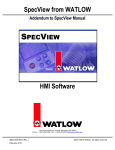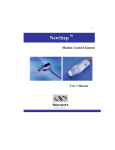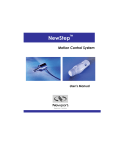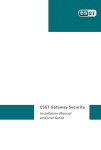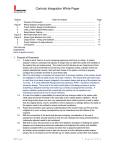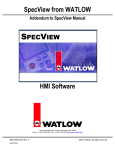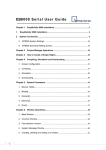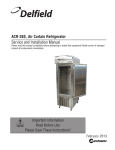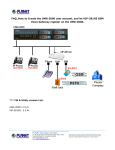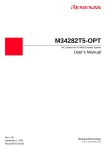Download Silver Series Operator Interface Terminals Addendum to
Transcript
Silver Series EM Operator Interface Terminals Addendum to EZwarePlus Programming Manual Operator Interface Terminals 1241 Bundy Boulevard, Winona, Minnesota USA 55987 Phone: +1 (507) 454-5300, Fax: +1 (507) 452-4507 http://www.watlow.com 0600-0102-0000 Rev. A April 2014 ©2014 Watlow. All rights reserved. TC Table of Contents Chapter 1: Introduction ..................................................................................3 Additional Resources .................................................................................3 Chapter 2: Install and Wiring .........................................................................4 Connecting via Modbus RTU (232/485) .....................................................4 Connecting via Modbus TCP (Ethernet).....................................................4 Chapter 3: Communications Basics .............................................................6 About Gateways, Controllers and PLCs .....................................................6 Parameter Register Addresses ..................................................................6 Address Maps ............................................................................................7 Choosing a Communications Driver ...........................................................8 Addressing Parameters in Multiple Controllers ..........................................9 Address Offsets in Multi-Loop Controllers ..................................................9 Accessing Parameters via EZ-ZONE RUI Gateways and RM Access Modules .....................................................................................................9 Data Types............................................................................................... 10 Important Things to Know ........................................................................ 10 Chapter 4: Programming Tutorials ............................................................. 11 Create a First Project ............................................................................... 11 Create a Popup Window .......................................................................... 14 Create a Meter in a Popup Window ......................................................... 15 Add a Numeric Display............................................................................. 18 Add Increment and Decrement Buttons ................................................... 20 Add an Option List for Control Mode ........................................................ 23 Add a Button to Close the Popup Window ............................................... 25 Edit the Startup Window........................................................................... 26 Compile and Download the Project .......................................................... 29 Log Data .................................................................................................. 32 Create a Graph ........................................................................................ 37 Use Recipes............................................................................................. 40 EZ-ZONE® is a registered trademark of Watlow Silver Series EM OIT 2 Watlow Addendum 1 Chapter 1: Introduction The Silver Series EM Operator Interface Terminals (OITs) are powerful human machine interfaces for equipment and processes. EZwarePlus is easy-to-use and flexible software for creating the windows, buttons, displays, gauges and other screen items with which operators interact on the OIT. The purpose of this addendum is to quickly get you up and running with the OIT and software when used with Watlow controllers. Chapter 2: Install and Wiring provides information needed to physically connect the Silver Series EM OIT to power and Watlow products. Chapter 3:Introduction provides definitions and information necessary for using an OIT with Watlow controllers and other devices. Familiarity with these concepts is assumed in the tutorials that follow. Chapter 4: Programming Tutorials walks you through the steps of getting Watlow controllers communicating, creating user interfaces and using powerful user interface features such as trending, data logging and recipes with Watlow controllers. Additional Resources In addition to this addendum the following resources are available for learning about Silver Series EM OITs and EZwarePlus programming software: EZwarePlus Programming Manual—available at Watlow.com in the Download Center’s User Manuals section; search with the part number (0600-0100-0000) in the keyword field. Watlow Silver Series EM Installation Guide— available at Watlow.com in the Download Center’s User Manuals section; search with the part number (0600-0101-0000) in the keyword field. EZ-ZONE ALL Modbus register list in Excel—available at Watlow.com in the Download Center’s User Manuals section; search for “EZ-ZONE ALL” Silver Series Secrets video tutorial series—available at Watlow.com in the Download Center’s Training and Education section. Many of these were created for to the older EZware-5000, but they are still applicable. EZwarePlus Software Download for Silver Series EM—the latest version of software for programming Silver Series EM OITs from Watlow is always available at Watlow.com in the Download Center’s Software and Demos section; search with “EZware” in the keyword field.. Silver Series Sample Projects—available at Watlow.com in the Download Center’s Software and Demos section; search with “Silver Series EM” in the keyword field. Silver Series Frequently Asked Questions—along with other documents addressing specific topics related to using Silver Series OITs is available at Watlow.com in the Download Center’s Training and Education section. Silver Series EM OIT 3 Watlow Addendum 2 Chapter 2: Install and Wiring Consult the Watlow Silver Series EM Installation Guide for detailed information on installing and wiring the OITs. This chapter provides important additional information regarding connecting to and communicating with Watlow controllers. Connecting via Modbus RTU (232/485) The tables below indicate to which pins on the Silver Series EM OIT’s DB9 connectors the Watlow EZZONE® screw terminals should connect. Connecting via 485 2-wire Silver Series EM OIT Watlow Watlow EZ-ZONE TS00-0070-EM00 Cable1 TS00-0043-EM00 TS00-0100-EM00 Function COM1 COM3 COM1 COM3 Wire Color Terminals Function T-/R1 7 1 7 White/Brown CA T-/RT+/R+ 2 8 2 8 Brown CB T+/R+ Common 5 5 5 9 Blue CC Common 1 Supports COM1 only. Cable part number: 0219-0374-0000 for TS00-0070-EM00 and TS00-0100-EM00 or part number 0219-0388-0000 for TS00-0043-EM000 Connecting via 232 Silver Series EM OIT TS00-0043-0000 TS00-0070-0000 TS00-0043-E000 TS00-0100-0000 Function COM1 COM1 TXD 6 3 RXD 9 2 Common 5 5 Watlow EZ-ZONE Terminals C2 C3 C5 Function RD TX Common Connecting via Modbus TCP (Ethernet) With standard Ethernet cables connect the controller(s) and the Silver Series EM OIT to an Ethernet switch or connect the controller directly to the OIT. Determining or Setting the OIT’s IP Address If you connect the OIT to an Ethernet network in order to download programs or communicate with controllers via Ethernet, you must ensure the OIT has a unique IP address and you will need to know that address in order to communicate from your PC with the OIT. To read or set the OIT’s IP address: • Connect a USB mouse to the OIT, if desired. • Apply power to the OIT. • Once the OIT is powered up, move the mouse to the lower right corner of the OIT screen. • On the menu bar click the setting button (the one with the gear icon). • Enter the password. (By default this is 111111.) Silver Series EM OIT 4 Watlow Addendum • The IP address is listed in the System settings window on the Network tab. (If Auto Get IP Address is selected, the IP Address is not editable. If you want to configure the OIT for a fixed address, select IP address get from below, and enter the IP address here. • Click OK to close the System settings window on the OIT. Hints for using the Virtual Keyboard to enter the OIT password and IP addresses: • It can take a few seconds for the Systems settings dialog with the password field to appear. • If you do not see the Virtual Keyboard it may be minimized; click the keyboard icon on the menu bar. • Make sure the cursor is in the Password or IP address field on the System Settings dialog. • You can tell the password key strokes are being entered if you hear the key chirp from the OIT and see stars (******) appearing in the password field. • If you cannot see the Password field, arrange the Virtual Keyboard and System Settings dialog then make sure the cursor is in the Password field. Silver Series EM OIT 5 Watlow Addendum 3 Chapter 3: Communications Basics The Silver Series EM OIT can communicate with Watlow controllers via Modbus TCP or Modbus RTU. This section defines terms you will encounter and provides information about Modbus communications that will help you create a user interface with the Silver Series EM OIT for equipment and machines that include Watlow controllers. About Gateways, Controllers and PLCs The Silver Series EM OIT can communicate with a variety of devices. Because many of these devices are Programmable Logic Controllers (PLCs), EZwarePlus refers to devices in many places generically as “PLCs”. Don’t let this confuse you. When you are setting up the OIT to communicate with a Watlow product, from the OIT’s point of view the controller is a PLC. This addendum refers to configuring the Silver Series EM OIT to communicate with “controllers”, but the instructions apply equally to limit controllers and gateways such as the EZ-ZONE® RUI Gateway. Parameter Register Addresses The Modbus RTU and Modbus TCP communications protocols assume that each device’s memory is organized in blocks of like-data. Each data block contains either read-only data or read/write data and either bit-size data or word-size (16-bit) data. For example, the Coils data block contains read/write bits and the Input Register data block contains read-only words. Within each of these data blocks there is a range of memory locations. The data blocks are often referred to by the first digit of their address range. For example, the Holding Registers are often referred to as, “the 4x registers”. The Modbus standard defines both a numbering scheme and an addressing scheme for the memory locations in the data blocks. The table below illustrates this information for the four most commonly discussed data blocks. Name Coils Discrete Inputs Input Registers Holding Registers Number Access Data Size 0x 1x 3x 4x Read/Write Read-Only Read-Only Read/Write 1 bit 1 bit Word Word Memory Location Numbers (Absolute) 1 to 65,536 100,001 to 165,536 300,001 to 365,536 400,001 to 465,536 Memory Location Addresses (Relative) 0 to 65,535 0 to 65,535 0 to 65,535 0 to 65,535 Because the location numbering scheme includes the data block number, it is helpful to think of it as an absolute address. The absolute address specifies the address completely or absolutely in that it says which data block and which address contains a piece of data. Because the location addresses do not include the data block number, it is helpful to think of them as relative addresses. They specify where to look relative to the starting point of the data block. Some software and device manufacturers document the use of their products in terms of the numbering scheme while others use the addresses. In either case the manufacturer typically calls the numbers they Silver Series EM OIT 6 Watlow Addendum supply “the addresses.” So to use any two products together you need to know whether or not you have to convert the specified “address” in order to get the result you want. EZwarePlus’s Modbus drivers call the data block, “Device type” and for “Address” expect the memory location’s absolute address without the data block number. For example, to access a value in a holding register with absolute address 401,905, for Device type you select the data block “4x” and enter “1905” in the Address field. The following illustrates setting this address in EZwarePlus. (072) Watlow controllers use only the 4x registers. Therefore, you will set the Device type to 4x when accessing any parameter in a Watlow controller. Watlow manuals specify relative addresses. Therefore, you must add one (1) to an address found in a Watlow manual (other than this manual) before you enter it in EZwarePlus. For example, the EZ-ZONE PM Integrated Controller Models User’s Manual lists the relative address for Heat Power as 1904. To monitor the heat power with the Silver Series EM OIT, you will add one (1) to the relative address and enter “1905” in the Address field in EZwarePlus. (073) In summary, when setting an address for a screen object to read or write from a Watlow controller: • For the Device type select 4x. • Set the Address to a value that is one greater than the relative Modbus address listed in the Watlow controller manual. Address Maps Some EZ-ZONE products have user-selectable address maps. Select the desired map in the controller’s Setup Page, Communications menu with the Data Map parameter. The Data Map affects the parameter addresses at which values are read and written. The Data Map setting applies to all the parameters in the controller. Generally Map 2 provides access to more parameters. Silver Series EM OIT 7 Watlow Addendum For example, the EZ-ZONE PM Integrated Controller Models User’s Manual lists Map1 and Map 2 addresses for Process Value for Analog Inputs 1 and 2. If the Data Map parameter is set to Map 1 then the Process Value for Analog Input 2 is read at address 441 (the listed address plus one), but if Data Map is set to Map 2 then the Process Value for Analog Input 2 is read at address 451. The address for the Process Value for Analog Input 1 is the same for Map 1 and Map 2. (078) Choosing a Communications Driver When you create a project using EZwarePlus you select the drivers necessary to communicate with the Watlow controllers and any other devices with which the Silver Series EM OIT must communicate. For Watlow controllers, you select one of these drivers: • Modbus RTU Master—used with Watlow controllers that support Modbus RTU and communicate via RS-232 or RS-485. • Modbus TCP/IP Master—used with Watlow controllers that support Modbus TCP and communicate via Ethernet. Using the Modbus RTU Master Driver to Communicate via 485 When you set up the Silver Series EM OIT to communicate via 485, you add a Modbus RTU Master device to the device list in the System Parameter Settings. Only one driver is required for each COM port on the OIT to which controllers are connected. This is true regardless of the number of controllers that are connected to that 485 COM port. Think of the Modbus RTU Master device as a driver for the COM port not as a driver for the controllers themselves. That is why you choose the Modbus RTU Master driver rather than the Modbus RTU Slave driver. The controllers are slaves; the OIT’s COM port is the master. Using the Modbus RTU Master Driver to Communicate via 232 When you set up the OIT to communicate via a 232 COM port, you add a Modbus RTU Master device to the device list in the System Parameter Settings. When using 232 on a COM port, only one controller can be connected to that port. Using the Modbus TCP/IP Master Driver to Communicate via Ethernet When you set up the OIT to communicate with controllers via Ethernet, you add one Modbus TCP/IP Master device to the device list in the System Parameter Settings dialog for each controller that has an IP address with which you will communicate. For example, if the OIT must communicate with three EZ- Silver Series EM OIT 8 Watlow Addendum ZONE controllers via Ethernet, add three Modbus TCP/IP Master devices to the device list in the System Parameter Settings dialog each configured to communicate with one controller. Addressing Parameters in Multiple Controllers Normally the Silver Series EM OIT assumes that any register address you enter when communicating via Modbus RTU is associated with the controller at the network address you set in the PLC default station no field in the Device Properties under the System Parameter Settings. To read or write data from a register in another controller on a 485 network, enter the network address and register address separated by the number sign or hash mark (#). For example “3#2501” accesses register 2501 in the controller with the Modbus network address 3. (074) Address Offsets in Multi-Loop Controllers In controllers with more than one loop of control, more than one limit etc., there is more than one instance of each parameter for these duplicated functions. The manuals for controllers such as the EZZONE RM, list the Modbus address and an offset for these parameters. Add the offset to the address once to get the address of the second instance of the parameter, add it twice to get the third instance and so on. For example, the address of the Heat Power for Loop 1 is listed in the EZ-ZONE RM manual as 2244 with an offset of 70. The following table lists the addresses of the Heat Power parameter for each of the four possible loops in the controller. The table also reminds you to add one (1) to the relative addresses from the controller manuals before entering the parameter address in EZwarePlus. Loop 1 2 3 4 Address + Offset(s) 2224 2224 + 70 2224 + 70 + 70 2224 + 70 + 70 + 70 Convert Relative Address 2224 + 1 2294 + 1 2364 + 1 2434 + 1 Enter in EZwarePlus 2225 2295 2365 2435 Accessing Parameters via EZ-ZONE RUI Gateways and RM Access Modules Multiple EZ-ZONE devices can communicate with the Silver Series EM OIT via one or more EZ-ZONE RUI Gateways or EZ-ZONE RM Access modules. When ordered with either the Modbus TCP or Modbus RTU communications option, an RUI Gateway or RM Access module allows a Silver Series EM OIT to communicate with multiple EZ-ZONE controllers without purchasing communication options in each controller. Silver Series EM OIT 9 Watlow Addendum In such a system the Silver Series EM OIT is connected to and configured to communicate with the gateway. The gateway presents itself as a single device on the Modbus network; the OIT does not communicate with the controllers, only with the gateway. The gateway is configured by the user with an address offset for each controller connected to it. That address offset is added to the parameter addresses for the controller. For example, consider three EZ-ZONE PM controllers connected to an RUI Gateway configured with an offset of 0 for the first controller, 5000 for the second controller and 10,000 for the third controller. The table below indicates the addresses that must be entered in EZwarePlus to access the set point value in the three PM controllers. PM Set Point Plus Gateway Offset 1 2 3 2172 2172 2172 2172 + 0 2172 + 5000 2172 + 10000 Convert Relative Address 2172 + 1 7172 + 1 12172 + 1 Enter in EZwarePlus 2173 7173 12173 Data Types The Silver Series EM OIT’s Modbus drivers support a variety of data types. The Watlow manuals specify the data type of each parameter. However the terminology is not precisely the same. The table below correlates the data types indicated in the Watlow documentation with the data types you should select when configuring a screen object in EZwarePlus. EZ-ZONE User’s Manuals uint dint float EZ-ZONE ALL Modbus List Enumeration, unsigned 8-bit, Event, unsigned 16-bit signed 32-bit IEEE Float EZwarePlus 16-bit Unsigned 32-bit Signed 32-bit Float Important Things to Know Note: Make sure the Modbus Word Order is set to Word Low High in the controller. That is the setting that works with the Silver Series EM OIT. Note: Examples in this manual use the map 1 addresses. If the controller’s Data Map is set to 2, the examples may not work. Caution: When using a multi-state switch object to set an enumerated parameter in a controller, each time the user clicks the switch, the setting selected by the switch is sent to the controller. When it is desirable to go directly from one setting to another without intermediate settings, use a set word object or an option list to set the parameter instead. Silver Series EM OIT 10 Watlow Addendum 4 Chapter 4: Programming Tutorials The following sections guide you through creating a first project using EZwarePlus and a Silver Series EM OIT that communicates with a Watlow controller. Create a First Project The following procedure guides you through the process of configuring a Silver Series EM OIT to communicate with a Watlow Controller. 1) To launch EZwarePlus: on the Windows task bar click Start, click All Programs, click Watlow, click EZwarePlus and click EZwarePlus. 2) In the Welcome to EZwarePlus dialog, for Model, choose the OIT model you have. (001) Note: If you have previously created a project, that project will open. In that case from the File menu, choose New to create a blank project for this tutorial and to see the Welcome dialog. Note: The TS00-0070-EM00 and TS00-0100-EM00 are supported by the same driver. 3) For Display Mode choose Landscape. 4) Make sure Use template is selected. 5) Click OK. Silver Series EM OIT 11 Watlow Addendum 6) In the System Parameter Settings dialog, under the Device List, click New… (002) 7) For PLC type, choose the appropriate driver. See the table below. 8) For PLC I/F, choose the appropriate hardware interface. See the table below. 9) For PLC default station no. type the controller’s address. Typically this is 1 for the first controller. 10) Click Settings… (003) For part numbers like… STxx-xxx-xxxx PMxxxxx-1xxxxxx RMCxxxx-xxxx1xx RMHx-xxxx-x1xx RMLx-xxxx-x1xx RMSx-xxxx-x1xx Silver Series EM OIT with… For PLC type choose… For PLC I/F choose… Modbus RTU Modbus RTU Master RS-485 2W 12 Watlow Addendum For part numbers like… with… For PLC type choose… For PLC I/F choose… PMxxxxx-2xxxxxx EZKx-2xxx-xxxx RMAx-x2xx-xxxx Modbus RTU Modbus RTU Master RS-232 or RS-485 2W* PMxxxxx-3xxxxxx EZKx-3xxx-xxxx Modbus TCP Modbus TCP/IP Master Ethernet RMAx-x3xx-xxxx Other Watlow Controllers Modbus RTU Modbus RTU Master RS-232 or RS-485 2W* *Both 232 and 485 are available; choose the one to which you have connected the OIT. 11) For the Modbus RTU Master… • For COM, choose the communications port to which you have connected the controller. Typically this is COM 1. • For Baud rate, choose the rate that is set in the controller. (004) • For Data bits, choose 8 Bits. • For Parity, choose None. • For Stop bits, choose 1 Bit. • For multiple controllers on the same port, for Turn around delay (ms), enter 15 and for Send ACK delay (ms) enter 15. • Click OK. 12) For the Modbus TCP/IP Master… • For IP address, enter the IP address of the controller. • Click OK. 13) Click OK to close the Device Properties dialog. (005) Silver Series EM OIT 13 Watlow Addendum 14) To set up communications with controllers connected to other COM ports or to configure additional controllers communicating via Ethernet: • Click New... • Repeat from step 7 above. 15) Click OK to close the System Parameter Settings dialog. 16) Save the project: • From the File menu, choose Save. • In File name type First Project.emtp. • Click Save. Create a Popup Window This example assumes you have created a project that is configured to communicate with a Watlow controller and that project is open in EZwarePlus. 1) From the Window menu, choose Open Window. 2) Click New… (006) 3) Click Base Window. (007) Silver Series EM OIT 14 Watlow Addendum 4) Ensure the Name is Window_011 and the Window no. is 11. 5) Set Width to 420. 6) Set Height to 300 (272 for the 4.3 in. OIT). 7) To set the background color to white: • In the Background group, next to Color click . • Select the white color swatch. • Click OK. (008) 8) In the Popup window group, set Start pos. X to 120 (0 for the 4.3 in. OIT). 9) In the Popup window group, set Start pos. Y to 120 (0 for the 4.3 in. OIT). 10) Click OK. 11) In the Open Window dialog, select Window_11. 12) Click Open. 13) From the File menu choose Save. Create a Meter in a Popup Window This example assumes you have created a popup window in a project that is configured to communicate with a Watlow Controller and that window is open in EZwarePlus. 1) From the Objects menu, choose Meter Display. 2) Click the General tab. 3) In Description type Heat Power. 4) Click Setting… (009) Silver Series EM OIT 15 Watlow Addendum 5) For PLC name choose the Modbus Master or Modbus TCP/IP Master. 6) For Device type choose 4x. (075) 7) For Address enter the address of the heat power for your controller. See the table. 8) Select the data type in the field below the Address field. See the table. For this This Enter this Choose this controller… parameter… Address*… Data Type… RMCxxxx-xxxxxxx Heat Power 2245 32-bit Float RMHx-xxxx-x1xx Heat Power 4125 32-bit Float PMxxxxx-xxxxxxx Heat Power 1905 32-bit Float STxx-xxMx-xxxx Heat Power 237 32-bit Float ST via RUI Gateway Heat Power 1901 32-bit Float Other Controllers Consult the controller manual. *These addresses have already been changed to the absolute form required for EZwarePlus by adding 1 to the value listed in the Watlow manual. Enter them as listed 9) Click OK. Silver Series EM OIT 16 Watlow Addendum 10) Click the Outline tab. 11) In Degree set Start degree to 270. 12) In Degree set End degree to 90. 13) In Background uncheck Full circle. 14) In Tick marks check Enable. 15) For Tick marks Color, select black. 16) In Tick marks set Main scale to 6. 17) In Tick marks set Sub scale to 1. 18) In Tick marks set Length to 6. (010) 19) Click the Limits tab. 20) Set Value Zero to 0. 21) Set Value Span to 100. 22) Check Range limits Enable. 23) Set Width to 3. (011) 24) Click OK. 25) Move the cursor with the outline of the meter to position it and click to place the meter in Window_11. 26) Resize the meter with the corner handles to make it smaller, if necessary Silver Series EM OIT 17 Watlow Addendum 27) Double-click the meter to open the Meter Display Object’s Properties dialog. 28) Click the Profile tab. 29) Set X to 140. 30) Set Y to 60. (012) 31) Set Width to 140. 32) Set Width (%) to 100. 33) Click OK. 34) From the File menu choose Save. Add a Numeric Display This example assumes you have created a window in a project that is configured to communicate with a Watlow Controller and that window is open in EZwarePlus. 1) On the Objects menu, click Numeric/ASCII then choose Numeric Display. 2) Click the General tab. 3) In Description type Actual Closed Loop Set Point. 4) For PLC name choose Modbus RTU Master or Modbus TCP/IP Master. 5) For Address choose 4x and enter the address of the Closed Loop Working/Active Set Point for your controller. See the table. Silver Series EM OIT (013) For this This Enter this Choose this controller… parameter… Address*… Data Type… RMCxxxx-xxxxxxx 2513 32-bit Float Closed Loop RMHx-xxxx-x1xx 5233 32-bit Float Working/Active PMxxxxx-xxxxxxx 2173 32-bit Float Set Point STxx-xxMx-xxxx 204 32-bit Float (Read Only) ST via RUI Gateway 2173 32-bit Float Other Controllers Consult the controller manual. *These addresses have already been changed to the absolute form required for EZwarePlus by adding 1 to the value listed in the Watlow manual. Enter them as listed. 18 Watlow Addendum 6) On the Numeric Format tab. 7) In Data format set the data type. See the table. 8) On the Font tab set Align to Right. 9) Click OK. (013b) For this This Enter this Choose this controller… parameter… Address*… Data Type… RMCxxxx-xxxxxxx 2513 32-bit Float Closed Loop RMHx-xxxx-x1xx 5233 32-bit Float Working/Active PMxxxxx-xxxxxxx 2173 32-bit Float Set Point STxx-xxMx-xxxx 204 32-bit Float (Read Only) ST via RUI Gateway 2173 32-bit Float Other Controllers Consult the controller manual. *These addresses have already been changed to the absolute form required for EZwarePlus by adding 1 to the value listed in the Watlow manual. Enter them as listed. 10) Move the cursor with the outline to position the display field and click to place it. 11) Adjust the size of the field as needed. 12) From the File menu choose Save. (014) Silver Series EM OIT 19 Watlow Addendum Add Increment and Decrement Buttons This example assumes you have created a window in a project that is configured to communicate with a Watlow Controller and that window is open in EZwarePlus. To add a button that increments the set point: 1) On the Objects menu, click Button then choose Set Word. 2) Click the General tab. 3) In Description type Increment Set Point. 4) For PLC name choose Modbus RTU Master or Modbus TCP/IP Master. 5) Click Setting… 6) For Device type choose 4x. 7) For Address enter the address of the User Set Point for your controller. 8) Select the data type for the parameter in the field below the Address field. 9) Click OK. (015) Enter this Choose this Address*… Data Type… RMCxxxx-xxxxxxx 2501 32-bit Float RMHx-xxxx-x1xx 5221 32-bit Float Closed Loop PMxxxxx-xxxxxxx 2161 32-bit Float Set Point (Read/Write) STxx-xxMx-xxxx 22 32-bit Float ST via RUI Gateway 2161 32-bit Float Other Controllers Consult the controller manual. *These addresses have already been changed to the absolute form required for EZwarePlus by adding 1 to the value listed in the Watlow manual. Enter them as listed. For this controller… This parameter… 10) In Attribute for Set Style choose Press and hold increment (JOG++). 11) Set Inc. value to 1. 12) Set Upper Limit to 100 or a value that is safe for your controller’s set point. 13) Set JOG delay to 0.5 seconds. 14) Click the Shape tab. 15) Check Use shape. Silver Series EM OIT 20 Watlow Addendum 16) Click Shape Library… 17) Click the new library icon Select Lib… 18) In the EZwarePlus program’s library directory (typically: C:\Watlow\EZPlus\libr ary) select Arrows 1.plb. (016a) 19) Click Open. 20) Locate the button with the triangular arrow pointing up and click it. 21) Click OK to close the Shape Library. 22) Click OK to close the New Set Word Object dialog. (016) 23) Click to place the button. 24) Use the handles to adjust the size of the button. 25) Drag the button to place it as desired on the screen. 26) From the File menu choose Save. (017) Silver Series EM OIT 21 Watlow Addendum To add a button that decrements the set point: 1) Click the increment button to select it. 2) From the Edit menu, choose Copy. 3) From the Edit menu, choose Paste. 4) Drag the new button to an appropriate position. 5) Double click the new button to edit its properties. (018) 6) On the General tab change: • Description to Decrement Set Point • Set Style to Press and hold decrement (JOG--). 7) Set Bottom Limit to 0. 8) On the Shape tab click Shape Library… 9) Locate the button with the triangular arrow pointing down and click it. 10) Click OK to close the Shape Library. 11) Click OK to close the Set Word Object Properties dialog. 12) From the File menu choose Save. Silver Series EM OIT 22 Watlow Addendum Add an Option List for Control Mode This example assumes you have created a window in a project that communicates with a Watlow Controller and that window is open in EZwarePlus. 1) On the Objects menu, click Button then choose Option List. 2) Click the General tab. 3) In Comment type Control Mode. 4) Set Mode to Dropdown list. 5) Set Item No. to 3. 6) In the Monitor address group: • For PLC name choose Modbus RTU Master or Modbus TCP/IP Master. • Click Setting… • For Device type choose 4x. • In Address enter the address of the Control Mode. See the table. (019) Enter this Choose this Address*… Data Type… RMCxxxx-xxxxxxx 2221 16-bit Unsigned RMHx-xxxx-x1xx 4101 16-bit Unsigned PMxxxxx-xxxxxxx Control Mode 1881 16-bit Unsigned STxx-xxMx-xxxx 222 16-bit Unsigned ST via RUI Gateway 1881 16-bit Unsigned Other Controllers Consult the controller manual. *These addresses have already been changed to the absolute form required for EZwarePlus by adding 1 to the value listed in the Watlow manual. Enter them as listed. For this controller… This parameter… • Select the data type in the field below the Address field. • Click OK to close the Address dialog 7) Click the Mapping tab. Silver Series EM OIT 23 Watlow Addendum 8) In the Values column type the numeric and in the Item data the text that corresponds to each option you want to include. See the table. 9) Click OK to close the New Option List Object dialog. (020) Item 0 1 2 3 (error) Value 10 54 62 Enumerated Value Auto Manual Off 10) Position the cursor near the bottom center of the window layout and click to place the multi-state switch. (You may have to move the other objects around to fit everything.) 11) From the File menu choose Save. (022) Silver Series EM OIT 24 Watlow Addendum Add a Button to Close the Popup Window This example assumes you have created a window in a project that communicates with a Watlow Controller and that window is open in EZwarePlus. 1) On the Objects menu, click Button then choose Function Key. 2) On the General tab, in Comment type Close Window. 3) Select Close window. 4) On the Shape tab, uncheck Use shape. (023) 5) Check Use picture. 6) Click Picture Library… 7) Click the new library icon 8) Select Computer.flb. 9) Click Open. 10) Locate the circular grey button with the white x and click to select it. 11) Click OK to close the Picture Library. 12) On the Label tab, make sure Use label is not checked. (024) 13) Click OK to close the New Function Key Object dialog. 14) Click to place the function key in the upper right. 15) Double-click the function key to open the Function Key Object’s Properties dialog. Silver Series EM OIT 25 Watlow Addendum 16) Click the Profile tab 17) Set Position X to 375. 18) Set Position Y to 5. 19) Set Size Width to 40. 20) Set Size Height to 40. 21) Click OK. 22) From the File menu choose Save. (025) Edit the Startup Window This example assumes you have created a popup window open in EZwarePlus in a project that is configured to communicate with a Watlow Controller. To add text to the start up window: 1) From the Window menu, choose 1 10 – WINDOW_010. 2) From the Draw menu choose Text. 3) Set these text Attributes: • Choose a Font. • Set Color to white. • Set Size to 14. • Set Align to Left. 4) Edit Content to read, This is the Startup Screen. 5) Click OK. (026) Silver Series EM OIT 26 Watlow Addendum 6) Position the cursor centered in the top third of the window layout and click to place the text. 7) From the File menu choose Save. Add a Numeric Display to the main window: 1) On the Objects menu, click Numeric/ASCII and choose Numeric Display. 2) Click the General tab. 3) In Description type Process Variable. 4) For PLC name choose Modbus RTU Master or Modbus TCP/IP Master. 5) For Address choose 4x.and enter the address of the Analog Input 1 Process Value. See the table. (027) Enter this Choose this Address*… Data Type… RMCxxxx-xxxxxxx 361 32-bit Float RMHx-xxxx-x1xxx 381 32-bit Float Analog Input 1 PMxxxxx-xxxxxxx 361 32-bit Float Process Value STxx-xxMx-xxxx 20 32-bit Float ST via RUI Gateway 361 32-bit Float Other Controllers Consult the controller manual. *These addresses have already been changed to the absolute form required for EZwarePlus by adding 1 to the value listed in the Watlow manual. Enter them as listed. For this controller… This parameter… 6) Click the Numeric Format tab. 7) In Data format set the data type. 8) Set Right of decimal Pt. to 1. (028) 9) On the Font tab set Align to Right. 10) Click OK. (029) Silver Series EM OIT 27 Watlow Addendum 11) Move the cursor with the outline to position the display field in the center of the screen and click to place it. 12) From the File menu choose Save. (030) To create a function key on Window10: 1) On the Objects menu, click Button then choose Function Key. 2) On the General tab, in Comment type Loop 1 Settings. 3) Select Display popup window. 4) For Style choose No title bar. (031) 5) For Window no. select 11. Window_011. 6) Click the Shape tab. 7) Check Use shape. 8) Click Shape Library… 9) In the Library list select buttons1. 10) Click one of the buttons to select it. 11) Click OK to close the Shape Library. 12) Click the Label tab. 13) Check Use label. 14) Set Color to black. 15) Set Size to 16. 16) Set Align to Left. 17) In Content type Loop 1. Silver Series EM OIT 28 Watlow Addendum 18) Click OK. 19) Position the cursor and click to place the function key. 20) From the File menu choose Save. (032) Compile and Download the Project This example assumes you have a project that is ready to compile and load into an OIT. To compile the project: 1) From the Tools menu, choose Compile. 2) Click Compile. 3) After the project is compiled, click Close. (034) Silver Series EM OIT 29 Watlow Addendum To download via Ethernet: 1) Determine the OIT’s IP address: • If you don’t already know the OIT’s IP address, follow the instructions in Determining or Setting the OIT’s IP Address on page 4, note the IP address for use below. 2) In EZwarePlus from the Tools menu, choose Download. 3) HMI IP select or enter the OITs IP address. 4) Set Password to the OITs password (111111 by default). 5) Check Firmware, if not already checked. 6) Check Reboot HMI after download, if not already checked. 7) Click Download. 8) Once the download is complete, click Exit. (035) Silver Series EM OIT 30 Watlow Addendum To download the project via a USB drive to an OIT: 1) Connect at USB drive to the PC 2) From the Tools menu choose Build Data for USB Disk or SD Card Download… 3) Click Browse… (038) 4) Locate and select the USB drive. Note: Do not select a sub directory of the USB drive. Select the root. 5) Click OK to close the Browse For Folder dialog. (039) 6) Click Build. 7) When the files are transferred successfully, click OK. 8) Click Exit to close the USB Disk/CF Card/SD Card Data dialog. 9) Remove the USB drive from the PC. To download the from the USB drive to the OIT: 1) Connect the USB drive to the OIT. 2) When the download/Upload screen appears on the OIT click Download. Note: You only have a few seconds to do this before the screen times out. If you miss it, disconnect the USB drive and connect it again. Silver Series EM OIT 31 Watlow Addendum 3) With the Virtual Keyboard enter the Password. (By default this is 111111.) Note: If you have difficulty entering the password, see the hints below. 4) On the Download Settings dialog make sure Download Project Files is checked. 5) Click OK. 6) In the Pick a Directory dialog expand the usbdisk folder by clicking the plus (+) next to it. 7) Select the disk_a_1 folder. Note: The OIT represents the USB drive with a folder icon and a name it assigns such as disk_a_1. You can inspect the contents to be sure you pick the right one. The compiled project is in a directory called mt8000ie, but be sure to select the USB drive not a sub folder before proceeding. 8) Click OK. 9) Once the project downloads and runs, you can remove the USB drive from the OIT. Log Data This example assumes you have a project with at least one controller. There are two steps to log data with the OIT: • Copy data from the controller to contiguous local OIT memory with the Data Transfer (Timebased) object—this is necessary only if you want to log more than one parameter in the same file or show multiple parameters together in a Trend Display (graph) or a History Data Display (table). • Create a data log with the Data Sampling object. Note: This example uses specific addresses internal to the OIT. If you have used one or more of these for other purposes you will have to choose appropriate addresses for your project. To copy data to the OIT’s local memory: 1) From the Objects menu choose Data Transfer. Note: Do not choose the Data Transfer (Triggerbased) option. 2) For each item to be logged in the file: • Click New… (041) Silver Series EM OIT 32 Watlow Addendum • In Comment type a description of the data to be copied such as “PV 1”. • For Address type choose Word. • For Interval choose a value that is the same as or less than the amount of time you want between data samples. • In No. of words type word size of the parameter’s data type. See table. • For Source address PLC name choose Modbus RTU Master or Modbus TCP/IP Master. • For Source address device type choose 4x. • In Source address Address type the address of the parameter to be logged. (042) Data Type Float 16-bit integer 32-bit integer No. of words 2 1 2 Enter this Choose this Address*… Data Type… RMCxxxx-xxxxxxx 361 32-bit Float RMHx-xxxx-x1xxx 381 32-bit Float Analog Input 1 PMxxxxx-xxxxxxx 361 32-bit Float Process Value STxx-xxMx-xxxx 20 32-bit Float ST via RUI Gateway 361 32-bit Float Other Controllers Consult the controller manual. *These addresses have already been changed to the absolute form required for EZwarePlus by adding 1 to the value listed in the Watlow manual. Enter them as listed. For this controller… This parameter… • For Destination address PLC name choose the OIT (“Local HMI” by default). • For Destination address device type choose LW. • In Destination address Address type the local address at which to save the data to be logged. Note: Pick a range of addresses with room to store all the data that must be displayed. For example, use 200 for the first parameter to be logged then for each additional parameter increment the address by the size in words of the previous data. For example, typically you log floats such as process variables and set points which each require two words to store. In that case if the first process variable is copied to 200, set the next parameter to copy to 202 so on. In this example, a process variable, a set point and the heat output power are logged. • Click OK. Silver Series EM OIT 33 Watlow Addendum 3) Click Exit to close the Data Transfer (Timebased) Object window. (043) To set up data sampling to log the data: 1) On the Objects menu, click Data Logging then choose Data Sampling. 2) Click New… (044) 3) In Comment type a description for the set of data such as “Loop 1”. 4) For Sampling mode choose Time-based. 5) For Sampling time interval choose the time between samples. 6) For Read address PLC name choose the OIT (“Local HMI” by default). 7) For Read address device type choose LW. (045) Silver Series EM OIT 34 Watlow Addendum 8) In Read address Address type the first address to which data was copied. In the example, this is 200. 9) In Max. data records type the number of records to save in a file. 10) Click Data Format… 11) For each item to be logged in the file: • Click New… (046) • For Data type choose the data type of the item being logged. Typically 32-bit Float). • In Comment Enter a description for the item to be logged, for example “PV 1”. (047) • Click OK. 12) Click Exit to close the Data Format window. (048) 13) In the History Files group check one or more locations to which to save the data (Save to USB disk or Save to HMI memory). 14) In Folder name type a name for the folder in which the data log file should be created such as “datalog”. Silver Series EM OIT (049) 35 Watlow Addendum 15) Click OK to close the Data Sampling Object set up window. 16) Click Exit to close the Data Sampling Object window. (050) Silver Series EM OIT 36 Watlow Addendum Create a Graph This example assumes you have a project with at least one controller and that you have previously configured a time-based data sampling object. To create and open a window to use for the trend. 1) From the Window menu, choose Open Window. 2) Click New… (056) 3) Click Base Window. (007) 4) In Name type Trend. 5) Click OK. 6) In the Window list select Trend. 7) Click Open. (057) To create buttons to open the Trend window and return to the first window: 1) Select window 10. (064) 2) Select the function key on that screen by clicking it once. (065) 3) From the Edit menu, choose Copy. 4) From the Edit menu, choose Paste. 5) Place the copy next to the original. 6) Double-click the copy to open the Function Key Object’s Properties window. Silver Series EM OIT 37 Watlow Addendum 7) Edit the Comment to read Trend Graph Window. 8) Choose Change fullscreen window. 9) For Window no. choose 12. Trend. (066) 10) Click the Label tab. 11) Edit the Content to read Trend. 12) Click OK to close the Function Key Object’s Properties window. 13) If necessary, select the function key by clicking it. 14) From the Edit menu, choose Copy. 15) Select window 12 Trend. 16) From the Edit menu, choose Paste. 17) Position the button centered at the bottom of the screen. 18) Edit the new button’s properties so that it changes to full-screen window 10 Initial and is labeled “Back”. To create a trend graph: 1) On the Objects menu point to Data Logging and choose Trend Display. 2) In Comment type a description of the trend such as “Loop 1 PV, SP and Heat vs. Time”. 3) For Data Sampling Object index choose the data sampling object you previously configured. Silver Series EM OIT (051) 38 Watlow Addendum 4) For Trend type choose Real-time. 5) For Distance between data samples/X axis time range choose Time. 6) In Distance type the number of seconds the width of the trend graph will represent. For example, if you want to see two minutes of data at once, type 120. 7) Click the Trend tab. 8) Choose a Frame color and a Background color. (052) 9) Click the Channel tab. 10) For each channel to be graphed: • In the Data sampling object group check Display. • For Color choose a color that contrasts with the background color. • In Zero type the value that should be graphed at the bottom of the yaxis. • In Span type the value that should be graphed at the top of the y-axis. 11) Click OK. Silver Series EM OIT (076) Note: Keep in mind that while you can choose a different zero and span for each pen, you don’t want to confuse users, so it may be best to graph all the channels against the same zero an span values. 39 Watlow Addendum 12) Place and size the trend object. (053) 13) Optional: In the Trend Display Object Properties dialog Trend tab enable the Grid and set it up to display the time. (054) 14) Optional: Use the Scale tool to add a scale and labels with the Text tool. Color coordinate these or add a legend if the trend channels don’t all have the same zero and span. (055) Silver Series EM OIT 40 Watlow Addendum Use Recipes This example assumes you have a project with at least one controller in which the recipe memory has not already been used for something else. In this example we will create a recipe that has five parameters from one controller. For each parameter we will create a data transfer object that saves the parameter’s value in the recipe in the OIT. For these objects the source addresses are the parameters’ Modbus addresses in the controller and the destination addresses are RW (recipe word) addresses in the OIT. See the table. Note: This example uses specific addresses internal to the OIT. If you have used one or more of these for other purposes you will have to choose appropriate addresses for your project. To create a recipe window and link it to the other screens: 1) Create and open a window to use for viewing, saving and loading recipes called “Recipe Manager”. 2) Create a button on WINDOW 10 that opens the Recipe Manager window. 3) Create a button on the Recipe Manager window that opens window 10 Initial. Note: Refer to the Trend example if necessary. Repeat the following steps to add a data transfer object to the Recipe Manager screen for each parameter you want to save in a recipe. Refer to the table below for addresses etc.: Parameter Closed Loop Set Point Alarm High Set Point Heat Proportional Band Integral Derivative *ST via RUI Gateway Silver Series EM OIT “Source” Address in Controller RMC 2501 1741 2231 2235 2237 RMH 5221 2661 4111 4115 4117 PM 2161 1481 1891 1895 1897 41 ST 22 98 233 227 229 ST GTW* 2161 1481 1897 1891 1893 Size in Words 2 2 2 2 2 “Destination” Recipe Address 0 2 4 6 8 Watlow Addendum 1) From the Objects menu choose Data Transfer (Triggerbased). 2) In Comment type “Recipe Save:” and the name of the name of the parameter (such as “Loop 1 Set Point”. 3) For Source address PLC name choose Modbus RTU Master or Modbus TCP/IP Master. 4) For Source address choose 4x and enter the address of the parameter. 5) In No. of words type word size of the parameter’s data type. See Table. 6) Click Setting… 7) For Destination address PLC name choose the OIT (Local HMI by default). (060) Data Type Float 16-bit integer 32-bit integer No. of words 2 1 2 8) For Destination address Device type choose RW to store recipes in the battery backed up recipe word memory. 9) In Destination address Address type 0 for the first item in the recipe (Increment this by the previous item’s No of words for each subsequent recipe item. For example, if the first item was a 16-bit integer, the address of the second item is 1. If the second item is a float, the address of the third item is 3.) 10) If you want to store more than one recipe: • Check Destination address Index register. • For Destination address Index choose INDEX 0 (16-bit). Silver Series EM OIT 42 Watlow Addendum 11) Click OK to close the Address dialog 12) For Mode choose External Trigger. 13) For Trigger address PLC name choose the OIT (Local HMI by default). 14) For Trigger address Device type choose LB to use an internal bit to cause the OIT to store values in a recipe. 15) In Trigger address Address type 500. 16) Click the Label tab. 17) Check Use label. 18) Set State to 0. 19) In Content type the name of the parameter. 20) Click OK. 21) Place the Data Transfer (Trigger-based) object on the screen. Repeat the following steps to create the data transfer items that will load recipes in to the controller: Note: For the data transfer objects that load the recipe from the OIT to the controller, the source addresses are RW (recipe words) addresses in the OIT and the destination addresses are the parameters’ Modbus addresses in the controller. Parameter Closed Loop Set Point Alarm High Set Point Heat Proportional Band Integral Derivative *ST via RUI Gateway Silver Series EM OIT “Source” Recipe Address 0 2 4 6 8 Size in Words 2 2 2 2 2 “Destination” Address in Controller RMC 2501 1741 2231 2235 2237 43 RMH 5221 2661 4111 4115 4117 PM 2161 1481 1891 1895 1897 ST 22 98 233 227 229 ST GTW* 2161 1481 1897 1891 1893 Watlow Addendum 1) From the Objects menu choose Data Transfer (Triggerbased). 2) In Description type “Recipe Load:” and the name of the parameter (such as “Loop 1 Set Point”). 3) For Source address PLC name choose the OIT. 4) For Source address choose RW and type the recipe address for the item. (062) 5) If you set up the recipe save to use and index register: • Click Source address Settings… • Check Source address Index register • For Source address Index choose INDEX 0 (16-bit). • Click OK to close the Address dialog. 6) In No. of words type word size of the parameter’s data type. 7) For Destination address PLC name choose Modbus RTU Master or Modbus TCP/IP Master. 8) In Destination address Address choose 4x and enter the controller address of the parameter. 9) For Mode choose External Trigger. 10) For Trigger address PLC name choose the OIT (Local HMI by default). 11) For Trigger address Device type choose LB to use an internal bit to cause the OIT to load recipe values in to a controller. 12) In Trigger address Address type 501. 13) Click the Label tab. 14) Check Use label. 15) Enter the name of the parameter to display. 16) Click OK. 17) Place the Data Transfer (Trigger-based) object on the screen. Silver Series EM OIT 44 Watlow Addendum To create a button to trigger the data transfer objects to copy the values currently in the controller to the corresponding recipe memory in the OIT: 1) On the Objects menu, point to Button and choose Set Bit. 2) In Description type “Save Recipe”. 3) For PLC name choose the OIT (Local HMI by default). (063) 4) For Address choose LB and type 500. 5) For Set style Choose Momentary. 6) Click the Label tab. 7) Check Use label. 8) In Content for state 0 type “Save to OIT”. 9) Click OK. 10) Place the button. To create a button to trigger the data transfer objects to copy the values currently in the OIT’s recipe memory to the controller: 1) On the Objects menu, point to Button and choose Set Bit. 2) In Description type “Load Recipe”. 3) For PLC name choose the OIT (Local HMI by default). 4) For Address choose LB and type 501. 5) For Set style Choose Momentary. 6) Click the Label tab. 7) Check Use label. 8) In Content for state 0 type “Load from OIT”. 9) Click OK. 10) Place the button. Note: Using pictures for buttons may help operators. Silver Series EM OIT 45 Watlow Addendum Optional: To see what you are copying from the controller to the OIT’s recipe memory, create an object displaying the current value in the controller next to each Data Transfer (Trigger-based) object. Create a label that indicates what the fields are such as “Current Controller Values”. Optional: To see or edit directly what is saved in recipe memory create a data entry object for each recipe item. These objects should display the values of the data in the RW memory at the recipe addresses. Create a label that indicates what the fields are such as “Recipe Values”. (068) Optional: The values in the RW addresses are automatically saved in non-volatile memory every five minutes, but adding a button that momentarily sets LB9029 forces the values to be saved and can avoid lost data in the event the power is shut off too soon after editing a recipe. Optional: If you want to store more than one recipe in the OIT, set up the data transfer objects to use indexing for the RW addresses. Silver Series EM OIT (071) 46 Watlow Addendum Address indexing allows a screen object to display and set the value of different memory locations depending on the value in the index. In this example we use LW-9200 as the address index. Whatever value the index is set to is added to the address in the data transfer (and recipe display) objects. When the index value is zero, the first recipe is used. When the index is 10 the second recipe is used. When the index is 20 the third recipe is used. A multi-state switch is used to set the value of the index when the user selects the recipe. Recipe Selector Multi-State Switch Address = LW 9200 “Recipe 1” = State 0 = 0 “Recipe 2” = State 1 = 10 “Recipe 3” = State 2 = 20 Data Transfer Objects Data Transfer Object 1 (Lp 1 Set Point) Address = RW 0 + index Controller Memory 2161: (Lp 1 Set Point) 1481: (Lp 1 Hi Alarm) 1891: (Lp 1 Heat PB) 1895: (Lp 1 Integral) 1897: (Lp 1 Derivative) LW Memory LW 9200: address index RW Memory Recipe 1 (index = 0) RW 0: (Lp 1 Set Point) RW 2: (Lp 1 Hi Alarm) RW 4: (Lp 1 Heat PB) RW 6: (Lp 1 Integral) Data Transfer Object 2 (Lp 1 Hi Alarm) Address = RW 2 + index RW 8: (Lp 1 Derivative) Data Transfer Object 3 (Lp 1 Heat PB) Address = RW 4 + index RW 10: (Lp 1 Set Point) Data Transfer Object 4 (Lp 1 Integral) Address = RW 6 + index Data Transfer Object 5 (Lp 1 Derivative) Address = RW 8 + index Recipe 2 (index = 10) RW 12: (Lp 1 Hi Alarm) RW 14: (Lp 1 Heat PB) RW 16: (Lp 1 Integral) RW 18: (Lp 1 Derivative) Recipe 3 (index = 20) RW 20: (Lp 1 Set Point) RW 22: (Lp 1 Hi Alarm) RW 24: (Lp 1 Heat PB) RW 26: (Lp 1 Integral) RW 28: (Lp 1 Derivative) Note: You can also use the address index to create one screen that displays data for one loop at a time with a multi-state switch or option list that allow users to switch from one loop to another. Silver Series EM OIT 47 Watlow Addendum To select the recipe to save to or load from create a multi-state switch to select the recipe as follows: 1) On the Objects menu point to Buttons and choose MultiState Switch. 2) In Description type “Recipe Selector”. 3) Click Read address Setting… 4) For PLC name choose the OIT (Local HMI by default). 5) Check System tag. 6) For Device type choose LW-9200 (16bit) : address index 0. 7) Click OK to close the Address dialog. 8) Click Write address Setting… 9) For PLC name choose the OIT (Local HMI by default). (069) 10) Check System tag. 11) For Device type choose LW-9200 (16bit) : address index 0. 12) Click OK to close the Address dialog. 13) For Switch style choose JOG+. 14) For No. of states choose the number of recipes you want to store. 15) For Cyclical choose Enable. 16) Check User-defined mapping. Silver Series EM OIT 48 Watlow Addendum 17) Click Setting… 18) For each state enter the appropriate offset Value. For state 0 enter 0. For state 1 enter a value that will offset the beginning of the second recipe beyond the end of the first in the recipe memory. 19) Click OK to close the Mapping window. (070) Note: The first recipe is selected with the multi-state switch in its state 0. This recipe stores its values in the memory locations you entered in the data transfer objects with no offset from address indexing, so for state 0 the Value is 0. Calculate the minimum offset for the second recipe by finding the sum of the number of words in memory used to store the items in one recipe. The second recipe (state 1 for the multistate switch) should set the offset to this sum. The third recipe (state 2) should set the offset to twice the sum. The fourth recipe (state 3) should set the offset to three times the sum. And so on. 20) Click the Label tab. 21) Check Use label. 22) In Content enter a label indicating which recipe is selected. (For state 0 type “Recipe 1”, for state 1 type “Recipe 2” etc.) 23) Click OK and place the Multi-State Switch object on the screen. To create a button to save the recipes in non-volitile memory: 1) On the Objects menu point to Buttons and choose Set Bit. 2) In Comment type “Save Recipes”. 3) Click Write address Setting… 4) For PLC name choose the OIT (Local HMI by default). 5) Check System tag. 6) For Device type choose LB-9029 : save all recipe data to machine (set ON). 7) Click OK to close the Address dialog. 8) For Set style choose Momentary. 9) Click the Label tab. 10) Check Use label. 11) In Content enter, “Save Recipes”. 12) Click OK and place the Set Bit object on the screen. Silver Series EM OIT 49 Watlow Addendum Silver Series EM OIT 50 Watlow Addendum



















































